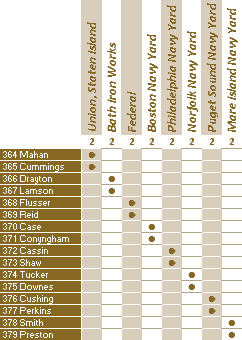
Length: 341' 3-5/8" overall; 334' design waterline.1
Beam: 34' 11-3/4" molded maximum; 35' 0-3/16" outside of plating at design waterline.1
Freeboard: 21 0-3/4" at bow; 10' 5" at stern.1
Displacement: 1,500 long tons design; 1,715 long tons to design waterline.1
Draft: 11' 5-1/2" mean; 13' 2-1/4" full load.3
Propulsion machinery: 4 x Foster Wheeler boilers; 465 psi, 645° F.; GE geared turbines; 50,000 shp; 2 shafts.1
Designed speed: 36.5 knots.2
Fuel bunkerage: 523.96 tons full load.1
Endurance: 7,800 nm at 12 knots.3
Designed complement: 13 officers; 193 enlisted.3
Torpedo battery: Twelve 21-inch trainable torpedo tubes: one quadruple centerline mount between the stacks; one quadruple wing mount on each side of the main deck abaft the after stack.
Main gun battery: as designed: 5 x dual purpose 5-inch/38 caliber guns: 2 forward in shielded pedestal mounts; 3 aft in open pedestal mounts; as built: 4 x dual purpose 5-inch/38 caliber guns: 2 forward in shielded pedestal mounts; 2 aft in open pedestal mounts.
Anti-aircraft battery: 1937: 4 x .50 cal. machine guns; 1945: 2 x 40mm Bofors in one twin mount; 6 x 20mm Oerlikon in single mounts.

As built, the Mahans also had a tripod foremast and a pole mainmast, giving them a silhouette similar to the Porter-class leaders whose construction immediately preceded them. Designed by Gibbs & Cox, they incorporated a new generation of destroyer machinery, which combined increases in pressure and temperature with a new type of lightweight, fast-running turbine, which was both simpler and more efficient than that of the Farraguts and proved highly reliable in service.
The US Navy eventually commissioned twenty-six destroyers with this machinery: the sixteen original Mahans plus the slightly-modified Dunlap and Fanning and eight ships of the Bagley class. (Three Mahans, with only four 5-inch mounts and 4 torpedo tubes, were also built for the Brazilian Navy.)
Cassin and Downes were completely destroyed in the Japanese attack on Pearl Harbor, but some of their equipment were salvaged and installed in new hulls, retaining their old numbers and names. Shaw’s bow was also demolished, but a temporary one was fitted and she steamed to the West Coast for reconstruction.
All ships screened carriers early in the war. Five were lost in the Solomon Islands campaign: Tucker in 1942, fouled in an American minefield off Espiritu Santo in the prelude to the Guadalcanal campaign; Cushing, first in line during the 12–13 November 1942 Battle of Guadalcanal, where she drew concentrated enemy fire; and Preston, with Benham and Walke, two nights later as part of Admiral Lee’s battleship force at Second Guadalcanal, an action which only Gwin among destroyers survived.
Drayton and Perkins were in the van with Fletcher and Maury, and Lamson was in the rear with Lardner at Tassafaronga, 30 November. Unlucky Perkins was run over by a troopship and lost the following year.
The last two losses—Mahan and Reid—occurred in the Philippines, December 1944. All remaining ships were scrapped between 1946 and 1948.
1 Bureau of Construction and Repair’s General Information book for USS Mahan and USS Cummings.
2 Bauer and Roberts.
3 Friedman.